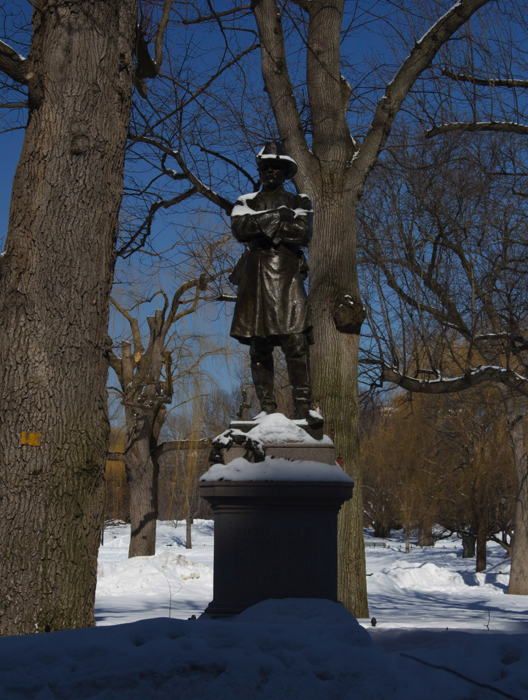Are you ready to feel the luck of the Irish? You don’t have to wait for St. Patrick’s Day or travel far to do it!
The month of March is widely known for our lively St. Patrick’s Day celebrations and festivities. But did you know that you can also learn about the history of the Irish in our three parks through public art? That’s right! A stroll through the Boston Common, the Public Garden, and the Commonwealth Avenue Mall can provide a glimpse into Boston’s Irish American culture and heritage through the lens of our beautiful sculptures. Prepare to be inspired by the stunning artwork that has become integral to our three parks and Boston’s unique and rich history.
Patrick Collins, Boston’s Second Irish-born Mayor (1902-05)
Commonwealth Avenue Mall (Between Clarendon and Dartmouth Streets)
Patrick Collins’s family moved to Boston from his birthplace in Ireland, Cork County, when he was a child.
Collins began his career as an upholsterer before joining the trade union movement and pursuing politics. He served four years in the MA state legislature, six years in Congress, and four years as US Consul General in London, appointed by President Grover Cleveland, before becoming Mayor of Boston.
In his first inaugural address, he said: “The chief trouble with commercial Boston is that it seeks to do all its best business in one square mile of land. The result is “congestion, high rents within that area, and somewhat ragged prospects. More business centers of the first class…will make Boston a better and a greater city. For this purpose, I may be counted an expansionist of the most extreme type.”
Collins passed away unexpectedly while in office, but due to his immense popularity, the Boston residents raised funds for his memorial in just six days through thousands of small contributions.
Boston Massacre Memorial
Boston Common (near Tremont Street between Avery St. and West St.)
The Boston Massacre Memorial on Boston Common has a strong Irish connection. The incident occurred on March 5, 1770, when British Army soldiers shot and killed Colonists while under attack by a mob.
In a very tense atmosphere, a mob formed around a British sentry, harassing him. Eight additional soldiers came to his aid, and the Boston crowd set upon them. The soldiers fired into the crowd without orders, instantly killing three people and wounding others. Two people died later of their wounds. The ethnicity and social status of the first two casualties in America’s fight for independence are worth noting. The first well-known casualty, Crispus Attucks, was of African and Wampanoag descent, and Thomas Carr, an Irish immigrant, also lost his life two days later due to the wounds he sustained. However, Carr’s testimony proved crucial in the court case defended by John Quincy Adams, which resulted in the successful defense of the British soldiers involved in the incident.
Commodore John Barry Memorial
Boston Common, along Tremont Street (Next to Visitors Information Center)
John Barry born in Ireland, County Wexford, went to sea as a young man, rising in the ranks, eventually making the maritime center of Philadelphia his home. As the young captain of The Black Prince, Barry set the record for the fastest day of sailing recorded in the 18th century. He presented an imposing figure on the deck at 6’4″ known as “Big John” Barry.
Barry had a life-long enmity of oppression and the British. When War with England seemed imminent, he offered his services to the fledgling Congress. He was tasked with outfitting the first Continental Navy ships at the outset of the Revolution. Barry won the first and the last naval battles of the Revolutionary War. He received Commission Number One in the new American Navy from President Washington in 1794. Barry outfitted and supervised the construction of the first frigates built under the Naval Act that same year. He is widely considered to be the Father of the American Navy.
Thomas Cass Memorial
Boston Public Garden, Boylston Street Mall
Thomas Cass was born in Queen’s County, Ireland in 1821. He moved to Boston with his family and became a successful businessman. During the Queen’s War, he raised a volunteer infantry regiment named the 9th Massachusetts, consisting mainly of Irish immigrants. The Boston Pilot, the official newspaper of the Archdiocese of Boston, provided the initial funding for the regiment, thanks to Patrick Donahoe, the publisher.
The 9th Massachusetts regiment fought bravely in several battles, including the Battle of Mechanicsville and the Battle of Malvern Hill, as part of the Union Army Peninsular Campaign to capture Richmond, Virginia. Tragically, in 1862, Colonel Cass was mortally wounded at Malvern Hill and died shortly after in Boston. He received a military funeral and was buried with honors at Mount Auburn Cemetery in Cambridge.
A memorial statue dedicated to Colonel Cass was erected in the Public Garden, but it received criticism for its lack of artistic excellence. Due to this, the Society of the Ninth Regiment commissioned a new bronze statue that stands there today.





